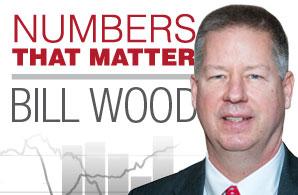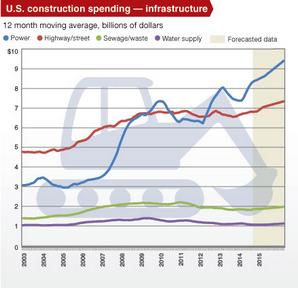Published: October 15, 2014 12:36 pm ET
Updated: October 15, 2014 12:40 pm ET

Data and forecasts pertaining to the residential construction and real estate sectors (housing starts, existing home sales, etc.) garner a lot of attention in the business media. This is because the trends in these data are good indicators of consumer spending behavior, and growth in the U.S. economy is heavily dependent on personal consumption.
But we should also closely monitor the trends in the data that measures nonresidential construction activity. The nonresidential construction sector is a huge end-market for several types of plastics products, and more importantly, it is an important indicator of the future health and vitality of the American economy.
The Census Bureau compiles data on a broad array of nonresidential construction categories. There are data measuring the investment in different types of buildings such as schools, factories, offices and shopping malls. And there are also spending data for what I call infrastructure projects: power, highways and streets, sewage and waste disposal, and water supply.
Because it is the election season, I think it is an appropriate time to take a look at the trends and my updated forecasts for spending on infrastructure projects. Regardless of which candidates emerge victorious in the upcoming elections, one area of concern that all elected officials will need to address is the imminent need to build and maintain our nation’s infrastructure. This will be true at all levels of government: federal, state and local.
Through the first eight months of 2014, spending growth has been the strongest for projects in the power category. We expect total spending for these projects to increase by 15 percent in 2014 followed by a rise of 10 percent in 2015.

Image By: U.S. Census Bureau, Mountaintop Economics & Research Inc.
This robust pace of investment is not surprising given the developments in the shale oil and natural gas industries. Plastics pipe used for the distribution of natural gas will be one of the segments that benefits directly from this growth trend, but the entire plastics industry will also benefit from the long-term access to domestically produced feedstocks.
Another sector that should experience solid growth in the coming year is spending for highways and streets.
The trend in this data has been steady to higher in recent years, and this should continue through next year. Constituents have little patience for faulty roads and they are not shy about letting their elected officials know it. Bridges that are structurally deficient are less obvious and more money needs to go into bridge repair. Nevertheless, we expect a gain of 5 percent in spending for highways and streets in 2014 and a rise of at least another 5 percent in 2015.
Investment in sewage and waste disposal infrastructure declined sharply in 2011 and 2012, but it has been stable recently. Spending in this category is obviously dependent on the trends in the residential construction data, and we expect gradual improvement in this data for the foreseeable future. An increase of 2 percent in overall spending for sewage projects in 2014 will accelerate to a gain of 5 percent in 2015.
The remaining category on the chart is spending for water supply projects. I mention this category last because of all the infrastructure categories, this one has the strongest growth potential for manufacturers of plastic pipe.
And unfortunately, this category has also experienced the slowest rate of growth in recent years.
Total spending in the water supply category suffered four consecutive years of decline coming out of the last recession before registering a small increase in 2013. Unfortunately, this uptrend was not sustained this year, and spending is on track to decline by 5 percent in 2014. We expect a reversal in the downtrend in 2015, but the growth rate is only expected to be a moderate 5 percent.
Water-related problems are becoming increasingly acute in many parts of the U.S., but it remains unclear as to whether there is yet sufficient political will to address them.
And from what I can tell so far, spending on infrastructure projects does not seem to be a hot-button topic for most political candidates this year. From my perspective, as both a citizen and an economist, I think this is a mistake.
Infrastructure is the foundation upon which our entire economy is built. Maintaining and expanding our massive infrastructure is expensive, but it is an investment that yields huge dividends in both economic activity and national security. We neglect it at our peril.
Now is a most auspicious time to aggressively increase our investment in infrastructure projects. I say this for several reasons. First, there are many areas in desperate need of attention. Many of this country’s bridges and water mains are structurally deficient and badly in need of repairs. Traffic congestion, disruptions in the supply of energy products and any problem with water supply create unnecessary inefficiencies and therefore impede our ability to achieve our economic potential.
The reason that infrastructure spending is so expensive is because it requires a large capital investment in labor, materials and equipment. But this is exactly what our economy needs at the present time — more jobs in the trades and in the factories that manufacture building materials and construction equipment. Increased investment in infrastructure will make our economy run smoother and more efficiently, and it will significantly expand consumer spending and new business investment at a time when our economy needs a boost.
The most pervasive argument against spending for these projects at the present time is that it will increase the budgets (and perhaps the deficits) at all levels of government. As a fiscal conservative, I am sensitive to these issues. But the stronger argument in my opinion is that we are going to have to spend the money at some point if we want to grow our economy, and we might as well borrow the money now while interest rates are at historically low levels and the labor market still has some slack in it.
Both of these factors will lower the burden on taxpayers. And unlike many parts of the federal and state budgets, infrastructure investments ultimately pay for themselves and then some.
| 